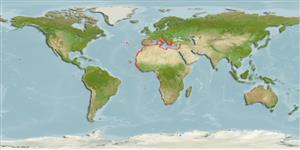Common names from other countries
Classification / Names / Names
Namen | Synonyme | Catalog of Fishes (gen., sp.) | ITIS | CoL | WoRMS
Environment: milieu / climate zone / depth range / distribution range
Ökologie
; tiefenbereich 3 - 50 m (Ref. 417). Tropical; 46°N - 17°S, 18°W - 36°E
Eastern Atlantic and the Mediterranean: France south to Angola and east to Turkey.
Length at first maturity / Size / Gewicht / Alter
Maturity: Lm ? range ? - ? cm Max length : 8.2 cm TL Männchen/unbestimmt; (Ref. 104052)
Body length: 8 cm; Common body length: 3.0 to 6.0 cm (Ref. 417). Maximum depth from Ref. 79120. Intertidal (Ref. 122842), inshore (Ref. 105612) or along coasts (Ref. 78235). Found in an estuary (Ref. 122841). On sand (Refs. 417, 79120), mud (Refs. 417, 79383) and seagrass (Ref. 122842).
Life cycle and mating behavior
Geschlechtsreife | Fortpflanzung | Ablaichen | Eier | Fecundity | Larven
Members of the order Decapoda are mostly gonochoric. Mating behavior: Precopulatory courtship ritual is common (through olfactory and tactile cues); usually indirect sperm transfer.
Schneider, W. 1990. (Ref. 417)
IUCN Rote Liste Status (Ref. 130435)
CITES Status (Ref. 108899)
Not Evaluated
Not Evaluated
Nutzung durch Menschen
Fischereien: weniger kommerziell
| FishSource |
Tools
Mehr Information
Alter/GrößeWachstumLänge-GewichtLänge-LängeMorphologieLarvenDichte
Internet Quellen
Estimates based on models
Preferred temperature
(Ref.
115969): 16.5 - 27.4, mean 20.1 (based on 174 cells).
Verwundbarkeit
Low vulnerability (10 of 100).
Preiskategorie
Unknown.
